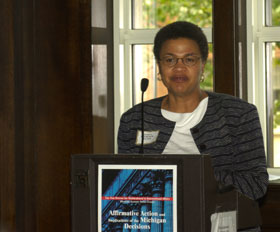|
This is an archived article.
For the latest news, go to the
Advance Homepage
For more archives, go to the Advance Archive/Search Page. | ||
|
Panel: Affirmative Action When the U.S. Supreme Court ruled in June that the University of Michigan Law School's method for diversifying its student body did not violate the constitution, admissions directors across the nation collectively exhaled, says James Morales, UConn's admissions director.
But he and several other members of an October 16 panel discussion about the decision said those directors shouldn't get too comfortable. "There will be another wave of litigation," said Lee Cokorinos, research director for the Institute for Democracy Studies in New York and author of The Assault on Diversity: An Organized Challenge to Racial and Gender Justice. "Some litigation has already been filed, against several federal [diversity] programs," and a "threatening letter" has been sent to officials at the University of Texas warning them that they too will be sued unless they alter their method of selecting diverse classes, he said. The panel discussion on "Affirmative Action and Implications of the Michigan Decisions," sponsored by the Division of Multicultural and International Affairs, was the first event in what will become an annual diversity lecture series. The panel featured Cokorinos; John Brittain, a former UConn law school professor who is now professor and dean emeritus at the Thurgood Marshall School of Law at Texas Southern University; Charles Krich, principal attorney for the Connecticut Commission for Human Rights and Opportunities; Karla Spurlock-Evans, dean of multicultural affairs at Trinity College; Peter H. Schuck, the Simeon E. Baldwin Professor of Law at Yale University; and Morales. "We wanted to assess where we are, now that the smoke has cleared from the Michigan decision," Ronald Taylor, vice provost for multicultural and international affairs, told the about 150 people attending. "What are the short-term and long-term effects of the decision? Will it affect hiring and recruitment? What type of litigation will be next?" Peter Schuck, the Yale professor and an expert on diversity and the law, agreed with Cokorinos that the battle over affirmative action has not been won. "Affirmative action has little public support," he said. "Seventy-seven percent of Hispanics and one-third of African-Americans oppose affirmative action in the workplace. In higher education also, both groups are against affirmative action. And the numbers are just as big among the egalitarian left as among the conservative right. "These polls and other discourse raise doubts that Grutter [the plaintiff in the Michigan law school case] crafted something that will change the way we do things," he said. Cokorinos said the two Michigan cases "did not come out of the blue. There are specific conservative organizations, like the Center for Individual Rights, which have taken the lead in attacking affirmative action." He said that since the Supreme Court ruled 25 years ago in Regents of the University of California v. Bakke, the landmark affirmative action litigation that first established the right of colleges to use race as a factor in admissions, "specialist boutique think tanks have appeared, and are making a determined effort to undercut civil rights law." Cokorinos said these groups of young attorneys "shape the strategic litigation agenda of the right." Brittain, the former UConn professor, didn't dispute Cokorinos' premise of a conservative attack, but he also doesn't think the situation is as dire as his colleagues charged. "Affirmative action will not die and the conservatives cannot kill it, even though it's been on the ropes," Brittain said. Pointing to the support the University of Michigan received from many Fortune 500 businesses and a group of high-ranking military officers, he said the need for diversity in all schools, workplaces, and branches of the armed forces is widely recognized. For now, though, admissions officers are allowed to use race as a factor, and underrepresented populations are growing on most college campuses, says Karla Spurlock-Evans, dean of multicultural affairs and director of affirmative action at Trinity College in Hartford. While still ensuring that underrepresented students are welcomed and secure in their new environments, Spurlock-Evans said the time has also come to expand interaction between minority and majority students. She said that in 1977, when she first became a multicultural administrator, "cultural centers were a place for minority students to touch base, to be in an environment where they were comfortable and could be with others who looked like them. That was acceptable in 1977, but more is being asked of universities today. The centers cannot be exclusive. Students can honor their backgrounds, but they must be open and welcoming to all. At Trinity, we're asking them to reach out and partner with others." Morales, UConn's admissions director, said his joy at the decision in June was quickly tempered by the reality. "No sooner did I sigh, than my expression of relief became an expression of consternation." He said the Supreme Court decision immediately raised more questions than it answered, by not defining many of its key findings, in effect leaving admissions officers to interpret the ruling in many different ways. The bottom line, he said, is that "There's no single approach that works for every institution, and that's probably just what the court had in mind." UConn, which has a minority population of about 18 percent, does not use a point system for admission. The point system used at the University of Michigan was deemed unconstitutional, in the same Supreme Court decision that affirmed the methods used by the university's law school. Morales says applications to UConn are judged on many factors, including standardized test scores, class rankings, how rigorous applicants' high school courses were, participation in extracurricular activities, an essay, and whether a particular applicant is the first person in his or her family to attend college. |

